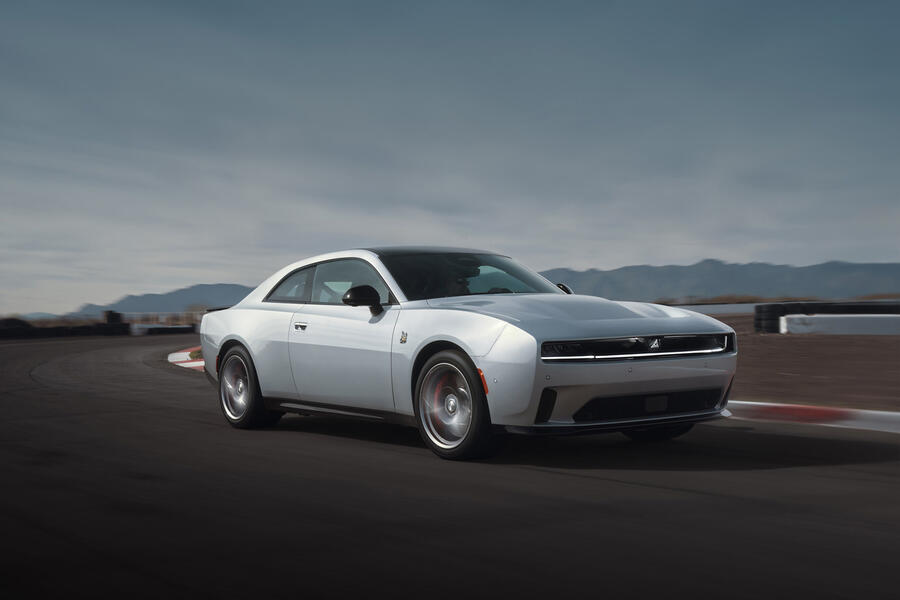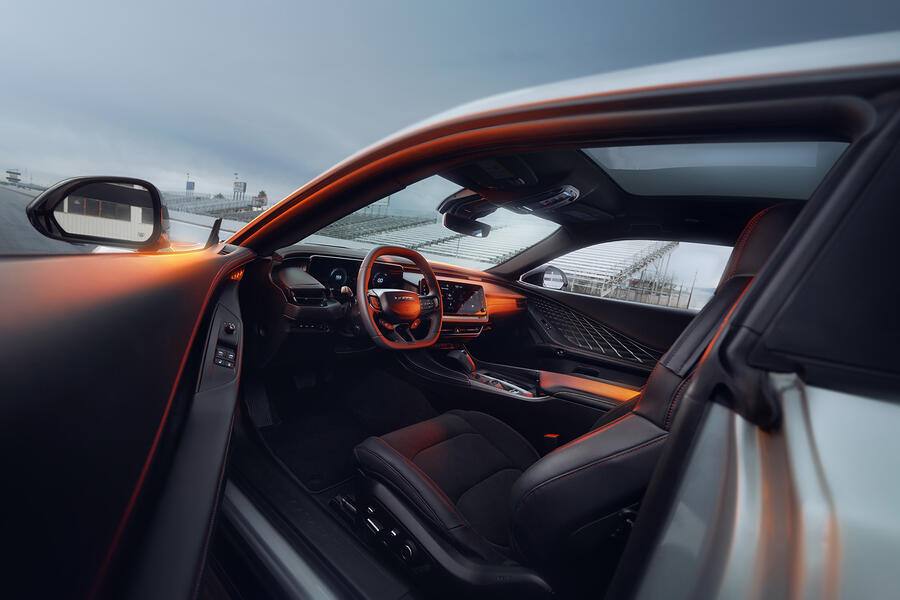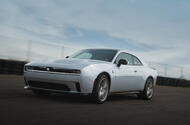All-new muscle car seats five, hits 60mph in 3.3sec and promises Hellcat levels of noise, even in EV form
The eighth-generation Dodge Charger has been unveiled, dropping its long-running Hemi V8 engine for a choice of straight-six or battery-electric power.
The new Charger Daytona's combustion offering is the twin-turbocharged 3.0-litre Hurricane six from the Jeep Grand Wagoneer. Dubbed the Sixpack, it sends 420bhp (‘standard output’) or 550bhp (‘high output’) through all four wheels.
Dodge has yet to provide detailed performance statistics for the Sixpack muscle cars. What the American brand has elaborated on, however, is the potential of the Charger Daytona EV.
The range-topping Scat Pack features dual permanent-magnet synchronous motors with silicon-carbide inverters, producing a combined 630bhp and 627lb ft as standard.
Using the Powershot, a 15.0sec overboost mode whose name references the traditional shot of nitrous oxide in drag racers, ouptut is boosted to 670bhp – nearly as much as in the wild 707bhp V8 Charger Hellcat.
This enables the Scat Pack to dispatch the 0-60mph sprint in 3.3sec, despite weighing all of 2648kg. Covering a quarter-mile is said to take 11.5sec and top speed is rated at 134mph.
For reference, the Tesla Model S Plaid electric saloon's tri-motor set-up produces 1020bhp, giving it a 0-60mph time of 2.4sec and a claimed quarter-mile time of 9.2sec.

Scat Pack cars can optionally be equipped with the Track Pack, which aims to boost cornering performance. The springs are stiffened and the monotube dampers are swapped for adaptive units, while the disc brakes are swapped for Brembo units with a diameter of 410mm. It also gains a staggered tyre set-up, wearing Goodyear Eagle F1 Supercar 3 rubber that measures 305mm wide up front and 325mm wide at the rear.
In the entry-level Charger Daytona R/T, the dual-motor system's outputs are reduced to 456bhp (496bhp using Powershot) and 404lb ft.
It hits 60mph from a standstill in 4.7sec and completes the quarter-mile sprint in 13.1sec. Its top speed is 137mph – slightly greater than that quoted for the shorter-geared Scat Pack.
The R/T also receives slightly smaller brakes (354mm in diameter), softer springs, dampers tuned for comfort and 18in alloys, rather than the 20in wheels worn by the Scat Pack.

Electric variants of the Charger Daytona feature a 400V electrical architecture and a 100.5kWh (93.9kWh usable) battery pack. This provides a range of 317 miles between charges in the R/T, according to the US’s EPA test cycle (which is tougher than the WLTP cycle used in Europe). The more powerful Scat Pack yields 260 miles.
The battery can be charged at rates of up to 183kW, allowing for a 20-80% charge in 27 minutes.
Dodge said the battery can discharge energy at rates up to 550kW – more than the 500kW maximum drawn by the Scat Pack's two motors. This hints at the potential for electric variants with up to 738bhp at a later time.
Indeed, parent company Stellantis previously said the STLA Large platform underpinning the Charger Daytona will eventually allow for 0-60mph times of 2.0sec. It referenced the V8 Hellcat as the benchmark for power outputs, in a further implication that the model could survive the shift to electric power.Â

The EVs receive a Fratzonic exterior sound generator, like that featured on the Abarth 500e, which is said to make them as noisy as the Hellcat.
The combustion and electric Charger Daytonas are otherwise indistinguishable from one another. They will be offered in two-door and four-door forms, with electric two-door cars hitting USÂ roads before the end of 2024.
Visually, the Mk8 Charger is clearly inspired by the legendary Mk2, with a rakish roofline and headlights neatly integrated into a blacked-out front grille. In a further reference to Dodge’s heritage, the grille wears the triangular ‘Fratzog’ logo last used on one of the brand’s cars in 1976.

At the rear, the new car retains the Mk7's signature LED lightbar but with a rectangular design also reminiscent of the smaller Dodge Challenger.
Inside, the Charger Daytona is offered with the choice of a 10.25in or 16.0in digital instrument display, flanked by a 12.3in infotainment touchscreen that's angled toward the driver.
It seats five people, with the 60/40-split rear bench able to fold down to boost luggage capacity.

Pricing has yet to be announced for the US. Stellantis currently has no plans for a UK launch, a company spokesperson told Autocar.






